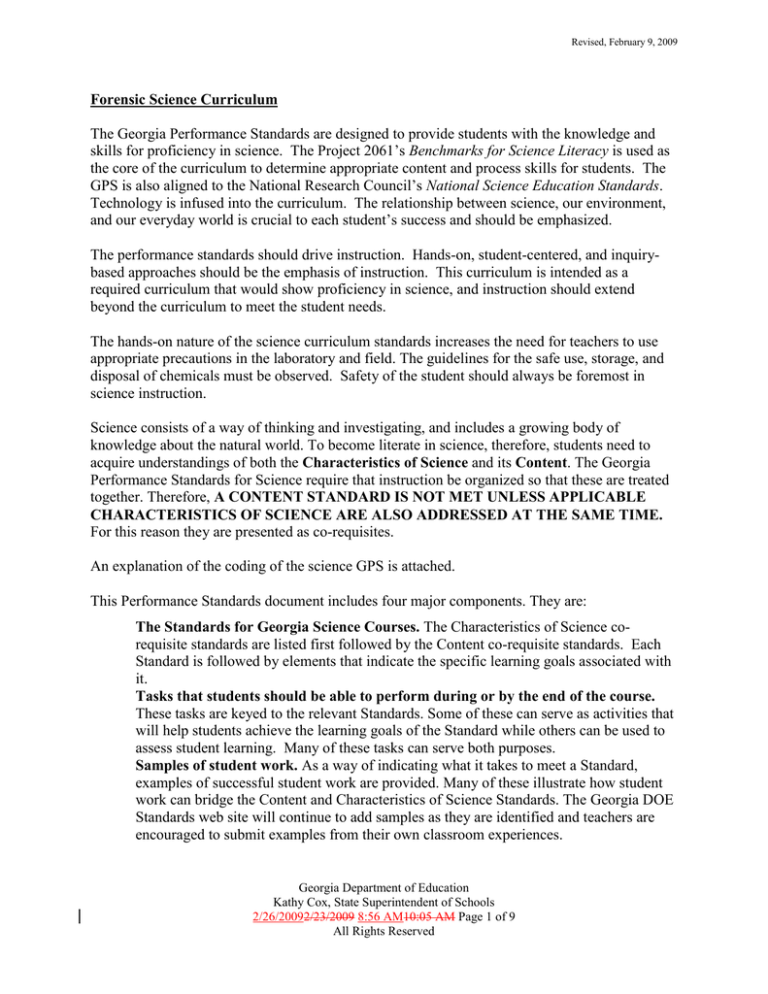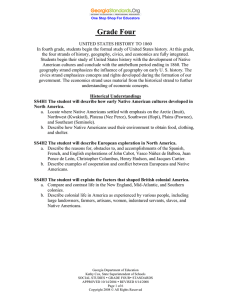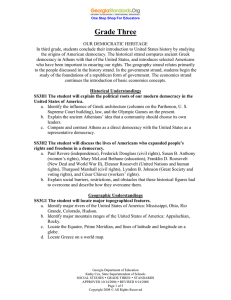
Revised, February 9, 2009
Forensic Science Curriculum
The Georgia Performance Standards are designed to provide students with the knowledge and
skills for proficiency in science. The Project 2061’s Benchmarks for Science Literacy is used as
the core of the curriculum to determine appropriate content and process skills for students. The
GPS is also aligned to the National Research Council’s National Science Education Standards.
Technology is infused into the curriculum. The relationship between science, our environment,
and our everyday world is crucial to each student’s success and should be emphasized.
The performance standards should drive instruction. Hands-on, student-centered, and inquirybased approaches should be the emphasis of instruction. This curriculum is intended as a
required curriculum that would show proficiency in science, and instruction should extend
beyond the curriculum to meet the student needs.
The hands-on nature of the science curriculum standards increases the need for teachers to use
appropriate precautions in the laboratory and field. The guidelines for the safe use, storage, and
disposal of chemicals must be observed. Safety of the student should always be foremost in
science instruction.
Science consists of a way of thinking and investigating, and includes a growing body of
knowledge about the natural world. To become literate in science, therefore, students need to
acquire understandings of both the Characteristics of Science and its Content. The Georgia
Performance Standards for Science require that instruction be organized so that these are treated
together. Therefore, A CONTENT STANDARD IS NOT MET UNLESS APPLICABLE
CHARACTERISTICS OF SCIENCE ARE ALSO ADDRESSED AT THE SAME TIME.
For this reason they are presented as co-requisites.
An explanation of the coding of the science GPS is attached.
This Performance Standards document includes four major components. They are:
The Standards for Georgia Science Courses. The Characteristics of Science corequisite standards are listed first followed by the Content co-requisite standards. Each
Standard is followed by elements that indicate the specific learning goals associated with
it.
Tasks that students should be able to perform during or by the end of the course.
These tasks are keyed to the relevant Standards. Some of these can serve as activities that
will help students achieve the learning goals of the Standard while others can be used to
assess student learning. Many of these tasks can serve both purposes.
Samples of student work. As a way of indicating what it takes to meet a Standard,
examples of successful student work are provided. Many of these illustrate how student
work can bridge the Content and Characteristics of Science Standards. The Georgia DOE
Standards web site will continue to add samples as they are identified and teachers are
encouraged to submit examples from their own classroom experiences.
Georgia Department of Education
Kathy Cox, State Superintendent of Schools
2/26/20092/23/2009 8:56 AM10:05 AM Page 1 of 9
All Rights Reserved
Revised, February 9, 2009
Teacher Commentary. Teacher commentary is meant to open the pathways of
communication between students and the classroom teacher. Showing students why they
did or did not meet a standard enables them to take ownership of their own learning.
Georgia Department of Education
Kathy Cox, State Superintendent of Schools
2/26/20092/23/2009 8:56 AM10:05 AM Page 2 of 9
All Rights Reserved
Revised, February 9, 2009
Georgia Performance Science Standards-- Explanation of Coding
Characteristics of Science Standards
SKCS1
Science Kindergarten Characteristics of Science Standard #1
S8CS2
Science Grade 8 Characteristics of Science Standard #2
SCSh8
Science Characteristics of Science high school Standard #8
Content Standards
S5P3
Science Grade 5 Physical Science Standard #3
S4E2
Science Grade 4 Earth Science Standard #2
S7L4
Science Grade 7 Life Science Standard #4
SC1
Science Chemistry Standard #1
SB4
Science Biology Standard #4
SPS6
Science Physical Science Standard #6
SP3
Science Physics Standard #3
SAST2
Science ASTronomy Standard #2
SEC1
Science ECology Standard #1
SFS3
Science Forensic Science Standard #3
Georgia Department of Education
Kathy Cox, State Superintendent of Schools
2/26/20092/23/2009 8:56 AM10:05 AM Page 3 of 9
All Rights Reserved
Revised, February 9, 2009
Forensic Science
The Forensic Science curriculum is designed to build upon science concepts and to apply science
to the investigation of crime scenes. It serves as a fourth year of science for graduation and may
serve in selected Career Technology programs. Students will learn the scientific protocols for
analyzing a crime scene, how to use chemical and physical separation methods to isolate and
identify materials, how to analyze biological evidence and the criminal use of tools, including
impressions from firearms, tool marks, arson, and explosive evidence.
Major Concepts/Skills
Collection & recording of data
Legal roles & duties of investigators
Extrapolation of evidence
Physical & chemical separation
Chemical analysis
Physical analysis
Biological analysis
Toxicology/serology
Anthropology of crime scene
Entomological techniques
DNA analysis
Weapon impression analysis
Concepts/Skills to Maintain
Characteristics of Science
Records investigations clearly and accurately
Uses scientific tools
Interprets graphs, tables, and charts
Writes clearly
Uses proper units
Organizes data into graphs, tables, and charts
Analyzes scientific data via calculations and inference
Uses models
Asks quality questions
Uses technology
Uses safety techniques
Recognizes the importance of explaining data with
precision and accuracy
Georgia Department of Education
Kathy Cox, State Superintendent of Schools
2/26/20092/23/2009 8:56 AM10:05 AM Page 4 of 9
All Rights Reserved
Revised, February 9, 2009
Co-Requisite – Characteristics of Science
Habits of Mind
SCSh1.
Students will evaluate the importance of curiosity, honesty, openness, and
skepticism in science.
a. Exhibit the above traits in their own scientific activities.
b. Recognize that different explanations often can be given for the same evidence.
c. Explain that further understanding of scientific problems relies on the design and
execution of new experiments which may reinforce or weaken opposing
explanations.
SCSh2.
Students will use standard safety practices for all classroom laboratory and field
investigations.
a. Follow correct procedures for use of scientific apparatus.
b. Demonstrate appropriate technique in all laboratory situations.
c. Follow correct protocol for identifying and reporting safety problems and
violations.
SCSh3.
Students will identify and investigate problems scientifically.
a. Suggest reasonable hypotheses for identified problems.
b. Develop procedures for solving scientific problems.
c. Collect, organize and record appropriate data.
d. Graphically compare and analyze data points and/or summary statistics.
e. Develop reasonable conclusions based on data collected.
f. Evaluate whether conclusions are reasonable by reviewing the process and
checking against other available information.
SCSh4.
Students use tools and instruments for observing, measuring, and manipulating
scientific equipment and materials.
a. Develop and use systematic procedures for recording and organizing information.
b. Use technology to produce tables and graphs.
c. Use technology to develop, test, and revise experimental or mathematical models.
SCSh5.
Students will demonstrate the computation and estimation skills necessary for
analyzing data and developing reasonable scientific explanations.
a. Trace the source on any large disparity between estimated and calculated answers
to problems.
b. Consider possible effects of measurement errors on calculations.
c. Recognize the relationship between accuracy and precision.
d. Express appropriate numbers of significant figures for calculated data, using
scientific notation where appropriate.
e. Solve scientific problems by substituting quantitative values, using dimensional
analysis and/or simple algebraic formulas as appropriate.
Georgia Department of Education
Kathy Cox, State Superintendent of Schools
2/26/20092/23/2009 8:56 AM10:05 AM Page 5 of 9
All Rights Reserved
Revised, February 9, 2009
SCSh6.
Students will communicate scientific investigations and information clearly.
a. Write clear, coherent laboratory reports related to scientific investigations.
b. Write clear, coherent accounts of current scientific issues, including possible
alternative interpretations of the data.
c. Use data as evidence to support scientific arguments and claims in written or oral
presentations.
d. Participate in group discussions of scientific investigation and current scientific
issues.
The Nature of Science
SCSh7.
Students analyze how scientific knowledge is developed.
Students recognize that:
a. The universe is a vast single system in which the basic principles are the same
everywhere.
b. Universal principles are discovered through observation and experimental
verification.
c. From time to time, major shifts occur in the scientific view of how the world
works. More often, however, the changes that take place in the body of scientific
knowledge are small modifications of prior knowledge. Major shifts in scientific
views typically occur after the observation of a new phenomenon or an insightful
interpretation of existing data by an individual or research group.
d. Hypotheses often cause scientists to develop new experiments that produce
additional data.
e. Testing, revising, and occasionally rejecting new and old theories never ends.
SCSh8.
Students will understand important features of the process of scientific inquiry.
Students will apply the following to inquiry learning practices:
a. Scientific investigators control the conditions of their experiments in order to
produce valuable data.
b. Scientific researchers are expected to critically assess the quality of data including
possible sources of bias in their investigations’ hypotheses, observations, data
analyses, and interpretations.
c. Scientists use practices such as peer review and publication to reinforce the
integrity of scientific activity and reporting.
d. The merit of a new theory is judged by how well scientific data are explained by
the new theory.
e. The ultimate goal of science is to develop an understanding of the natural
universe which is free of biases.
f. Science disciplines and traditions differ from one another in what is studied,
techniques used, and outcomes sought.
Georgia Department of Education
Kathy Cox, State Superintendent of Schools
2/26/20092/23/2009 8:56 AM10:05 AM Page 6 of 9
All Rights Reserved
Revised, February 9, 2009
Reading Standard Comment
After the elementary years, students are seriously engaged in reading for learning. This process
sweeps across all disciplinary domains, extending even to the area of personal learning. Students
encounter a variety of informational as well as fictional texts, and they experience text in all
genres and modes of discourse. In the study of various disciplines of learning (language arts,
mathematics, science, social studies), students must learn through reading the communities of
discourse of each of those disciplines. Each subject has its own specific vocabulary, and for
students to excel in all subjects, they must learn the specific vocabulary of those subject areas in
context.
Beginning with the middle grades years, students begin to self-select reading materials based on
personal interests established through classroom learning. Students become curious about
science, mathematics, history, and literature as they form contexts for those subjects related to
their personal and classroom experiences. As students explore academic areas through reading,
they develop favorite subjects and become confident in their verbal discourse about those
subjects.
Reading across curriculum content develops both academic and personal interests in students.
As students read, they develop both content and contextual vocabulary. They also build good
habits for reading, researching, and learning. The Reading Across the Curriculum standard
focuses on the academic and personal skills students acquire as they read in all areas of learning.
SCSh9. Students will enhance reading in all curriculum areas by:
a. Reading in all curriculum areas
Read a minimum of 25 grade-level appropriate books per year from a variety
of subject disciplines and participate in discussions related to curricular
learning in all areas.
Read both informational and fictional texts in a variety of genres and modes
of discourse.
Read technical texts related to various subject areas.
b. Discussing books
Discuss messages and themes from books in all subject areas.
Respond to a variety of texts in multiple modes of discourse.
Relate messages and themes from one subject area to messages and themes in
another area.
Evaluate the merit of texts in every subject discipline.
Examine author’s purpose in writing.
Recognize the features of disciplinary texts.
c. Building vocabulary knowledge
Demonstrate an understanding of contextual vocabulary in various subjects.
Use content vocabulary in writing and speaking.
Explore understanding of new words found in subject area texts.
Georgia Department of Education
Kathy Cox, State Superintendent of Schools
2/26/20092/23/2009 8:56 AM10:05 AM Page 7 of 9
All Rights Reserved
Revised, February 9, 2009
d. Establishing context
Explore life experiences related to subject area content.
Discuss in both writing and speaking how certain words are subject area
related.
Determine strategies for finding content and contextual meaning for unknown
words.
Co-Requisite - Content
SFS1.
Students will recognize and classify various types of evidence in relation to the
definition and scope of Forensic Science.
a. Compare and contrast the history of scientific forensic techniques used in
collecting and submitting evidence for admissibility in court (e.g. Locard’s
Exchange Principle, Frye standard, Daubert ruling).
b. Distinguish and categorize physical and trace evidence (e.g. ballistics, drugs,
fibers, fingerprints, glass, hair, metal, lip prints, soil, and toxins).
c. Determine the proper techniques to search, isolate, collect, and record physical
and trace evidence.
d. Evaluate the relevance of possible evidence at the site of an investigation.
e. Organize relevant information to accurately develop and submit both scene and
analysis reports.
SFS2.
Students will use various scientific techniques to analyze physical and trace
evidence.
a. Identify and utilize appropriate techniques used to lift and evaluate readable,
latent, plastic and visible fingerprints.
b. Analyze the morphology and types of hair, fibers, soil and glass.
c. Evaluate how post mortem changes are used to determine probable time of death:
Rigor mortis
Livor mortis
Algor mortis
Gastric contents
d. Identify methods used for the evaluation of handwriting and document evidence.
e. Determine the appropriate uses of chromatography and spectroscopy in evidence
analysis.
SFS3.
Students will analyze the use of toxicology, serology, and DNA technology in
forensic investigations.
a. Classify toxins and their effects on the body.
b. Compare the effects of alcohol on blood alcohol levels with regard to gender, and
according to the law.
c. Evaluate forensic techniques used to isolate toxins in the body.
d. Differentiate the forensic techniques used to distinguish human and animal blood
e. Analyze the physics of blood stain patterns.
Georgia Department of Education
Kathy Cox, State Superintendent of Schools
2/26/20092/23/2009 8:56 AM10:05 AM Page 8 of 9
All Rights Reserved
Revised, February 9, 2009
f. Compare short tandem repeat patterns (STR) and relate to identifying the DNA of
an individual.
g. Explain the use of the DNA database for DNA profiling.
SFS4
Students will evaluate the role of ballistics, tool marks and evidence of arson in
forensic investigation.
a. Identify firearm lab tests used to distinguish the characteristics of ballistics and
cartridge cases.
b. Analyze the physics of ballistic trajectory to predict range of firing.
c. Recognize the forensic significance of tool marks, footwear and tire impressions
in an investigation.
d. Evaluate possible indicators of arson and criminal bombing.
SFS5
Students will evaluate the role of Forensics as it pertains to Medicolegal Death
Investigation.
a. Identify various causes of death (blunt force trauma, heart attack, bleeding, etc.).
b. Analyze evidence that pertains to the manner of death (natural, homicide, suicide,
accidental, or undetermined).
Georgia Department of Education
Kathy Cox, State Superintendent of Schools
2/26/20092/23/2009 8:56 AM10:05 AM Page 9 of 9
All Rights Reserved








